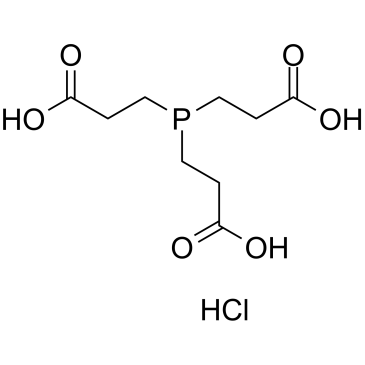Tris(2-carboxyethyl)phosphine Hydrochloride

Tris(2-carboxyethyl)phosphine Hydrochloride structure
|
Common Name | Tris(2-carboxyethyl)phosphine Hydrochloride | ||
|---|---|---|---|---|
| CAS Number | 51805-45-9 | Molecular Weight | 286.647 | |
| Density | 1.041 g/mL at 25 °C | Boiling Point | 519.4ºC at 760 mmHg | |
| Molecular Formula | C9H16ClO6P | Melting Point | 177 °C | |
| MSDS | Chinese USA | Flash Point | 267.9ºC | |
| Symbol |

GHS05 |
Signal Word | Danger | |
Use of Tris(2-carboxyethyl)phosphine HydrochlorideTCEP hydrochloride (Tris(2-carboxyethyl)phosphine hydrochloride) is a non-thiol reducing agent that is more stable and produces a faster S-S reductive reaction than other chemical reductants. TCEP hydrochloride is a trialkylphosphine, selectively reduces protein disuldes without altering the properties or interacting with thiol-directed agents in the reaction mixture. TCEP hydrochloride is also a commonly used reducing agent in the DNA/AuNP chemistry[1][2][3][4]. |
| Name | tris(2-carboxyethyl)phosphine hydrochloride |
|---|---|
| Synonym | More Synonyms |
| Description | TCEP hydrochloride (Tris(2-carboxyethyl)phosphine hydrochloride) is a non-thiol reducing agent that is more stable and produces a faster S-S reductive reaction than other chemical reductants. TCEP hydrochloride is a trialkylphosphine, selectively reduces protein disuldes without altering the properties or interacting with thiol-directed agents in the reaction mixture. TCEP hydrochloride is also a commonly used reducing agent in the DNA/AuNP chemistry[1][2][3][4]. |
|---|---|
| Related Catalog | |
| In Vitro | TCEP hydrochloride has been introduced which oers the prospect of serving as an alternative to the more commonly employed DTT in the NF-κB-DNA binding reactions in vitro, using recombinant p50 protein and a 32P-labelled κB oligonucleotide. DTT promotes NF-κB-DNA binding in concentrations from 0.25 to 2.6 mM in binding reactions. However, in the presence of 0.25 mM DTT, inhibition of NF-κB binding is seen only at Hg2+ concentrations greater than 100 μM and results are highly variable. In contrast, TCEP hydrochloride promotes NF-κB-DNA binding in a dose-related manner in concentrations from 0.25 to 6 mM. In the presence of even 6 mM TCEP hydrochloride, Hg2+ prevents NF-κB-DNA binding at concentrations as low as 20 μM in binding reactions[1]. The human lactoferrin (hLF) peptide is dissolved in phosphate buffer to a concentration of 0.1 mm. Reduction of the disulfide bonds is obtained by adding a 30-fold molar excess of TCEP hydrochloride with subsequent incubation for 2 h at 37 ℃[2]. |
| References |
| Density | 1.041 g/mL at 25 °C |
|---|---|
| Boiling Point | 519.4ºC at 760 mmHg |
| Melting Point | 177 °C |
| Molecular Formula | C9H16ClO6P |
| Molecular Weight | 286.647 |
| Flash Point | 267.9ºC |
| Exact Mass | 286.037292 |
| PSA | 125.49000 |
| LogP | 1.69440 |
| Appearance of Characters | powder | white |
| Index of Refraction | n20/D 1.367 |
| Storage condition | 2-8°C |
| Water Solubility | H2O: 50 mg/mL |
| Symbol |

GHS05 |
|---|---|
| Signal Word | Danger |
| Hazard Statements | H314 |
| Precautionary Statements | P280-P305 + P351 + P338-P310 |
| Personal Protective Equipment | Eyeshields;Faceshields;full-face particle respirator type N100 (US);Gloves;respirator cartridge type N100 (US);type P1 (EN143) respirator filter;type P3 (EN 143) respirator cartridges |
| Hazard Codes | Xi:Irritant; |
| Risk Phrases | R36/37/38 |
| Safety Phrases | S26-S37/39-S36/37/39-S27 |
| RIDADR | UN 3261 8/PG 2 |
| WGK Germany | 2 |
| Packaging Group | III |
| Hazard Class | 8.0 |
| HS Code | 2915900090 |
| HS Code | 2915900090 |
|---|---|
| Summary | 2915900090 other saturated acyclic monocarboxylic acids and their anhydrides, halides, peroxides and peroxyacids; their halogenated, sulphonated, nitrated or nitrosated derivatives VAT:17.0% Tax rebate rate:9.0% Supervision conditions:AB(certificate of inspection for goods inward,certificate of inspection for goods outward) MFN tariff:5.5% General tariff:30.0% |
|
Injectable Peptide Decorated Functional Nanofibrous Hollow Microspheres to Direct Stem Cell Differentiation and Tissue Regeneration.
Adv. Funct. Mater. 25(3) , 350-360, (2015) Injectable microspheres are attractive stem cell carriers for minimally invasive procedures. For tissue regeneration, the microspheres need to present the critical cues to properly direct stem cell di... |
|
|
Chitosan functionalisation of gold nanoparticles encourages particle uptake and induces cytotoxicity and pro-inflammatory conditions in phagocytic cells, as well as enhancing particle interactions with serum components.
J. Nanobiotechnology 13 , 84, (2015) Gold nanoparticles (AuNPs) are a popular choice for use in medical and biomedical research applications. With suitable functionalisation AuNPs can be applied in drug delivery systems, or can aid in di... |
|
|
Diatomite biosilica nanocarriers for siRNA transport inside cancer cells.
Biochim. Biophys. Acta 1840(12) , 3393-403, (2014) Diatomite is a natural porous biomaterial of sedimentary origin, formed by fragments of diatom siliceous skeletons, called "frustules". Due to large availability in many areas of the world, chemical s... |
| Propanoic acid, 3,3',3''-phosphinidynetris-, hydrochloride (1:1) |
| 3-[bis(2-carboxyethyl)phosphanyl]propanoic acid,hydrochloride |
| 3,3',3''-Phosphinetriyltripropanoic acid hydrochloride (1:1) |
| Tris(2-carboxyethyl)phosphine Hydrochloride |
| 3,3',3''-Phosphinetriyltripropanoic acid hydrochloride |
| MFCD00145469 |

